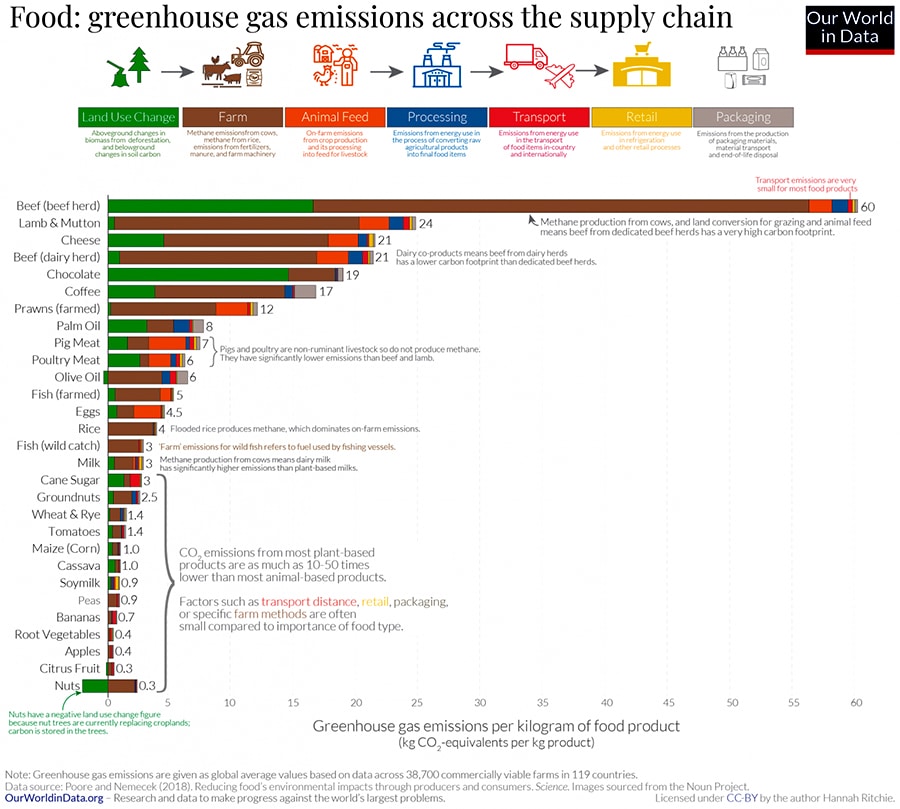

If you ask people what they can do about their diet to become more sustainable, most will talk about eating locally sourced food. But how much do food miles matter? What portion of our food’s environmental footprint comes from transportation? And more importantly, how do food miles compare with broader diet and lifestyle changes?
These questions become critically important as we weigh the most impactful changes we can make to our diet and our lifestyles moving forward. After all, knowing which decisions have the largest impacts will provide the clearest path forward as we begin to minimize our own environmental impacts both individually and as a society.
The notion that food miles account for a significant portion of food’s environmental footprint perhaps comes from our conflated mental associations between the tailpipe and emissions more broadly. These associations may lead us to overemphasize food miles above food choices. Choosing to eat locally sourced foods would make a big difference if transportation accounted for a substantial portion of food’s environmental footprint. But for most foods, transportation is responsible for only a small fraction of that footprint.
To understand where the emissions from our food come from, a study published in Science in 2018 analyzed data from one of the largest meta-analyses of the global food system and tabulated the relative sources of greenhouse emissions. The dataset represents roughly 38,000 commercially viable farms and 40 different agricultural products from 119 countries, accounting for nearly 90% of global protein and calorie consumption worldwide.[1] A visual representation of their findings is shown below.

Download the underlying data for this chart (.csv)[2]
What we eat has a vastly larger impact on our contribution to climate change than where the food comes from.
Looking closely, the most important takeaway is that there are enormous variances between greenhouse emissions among foods, with animal-based foods contributing much more heavily to climate change. Eating a locally sourced diet has minimal impact on reducing greenhouse emissions if that diet is laden with animal products. In fact, with only 4% of overall food production emissions coming from transportation, substituting meat with plant-based foods totalling less than one day’s worth of calories once per week reduces emissions more than buying all your food from local sources.[3] In other words, adopting Meatless Monday is more environmentally impactful than eating exclusively local food. By extension, going completely plant-based results in monumental reductions in greenhouse emissions.
This is not to say that there are no reasons to support local food systems. From the quality and freshness of foods harvested while ripe and in season, to shunning industrialized systems in favor of supporting local food producers, and yes, reductions in greenhouse emissions, there are many benefits to buying local foods. But at the end of the day, what we eat has a vastly larger impact on our contribution to climate change than where the food comes from. So if you are interested in reducing your own environmental footprint, consider the changes with the largest proportionate impacts—in this case, going whole food plant-based.
If you are interested in learning more about food and the related environmental impacts, pre-register for our new certificate program, where we explore the wide ranging effects food production has on natural environments, from land and water use to deforestation and ocean acidification. We also delve into the structure of the food system itself to understand the effects of consolidation on food policy, globalized food production systems, and food justice, empowering you to become a part of the solution for a more socially and environmentally just food system moving forward. Sign up for our newsletter for more course information: nutritionstudies.org/newsletter
References
- Poore J, Nemecek T. Reducing food’s environmental impacts through producers and consumers [published correction appears in Science. 2019 Feb 22;363(6429):eaaw9908. doi: 10.1126/science.aaw9908.]. Science. 2018;360(6392):987-992. doi:10.1126/science.aaq0216
- Ritchie H, Rosado P, Roser M. Environmental impacts of food production. OurWorldinData.org. Accessed April 3, 2025.https://ourworldindata.org/environmental-impacts-of-food
- Weber CL, Matthews HS. Food-miles and the relative climate impacts of food choices in the United States. Environ Sci Technol. 2008;42(10):3508-3513. doi:10.1021/es702969f
Copyright 2025 Center for Nutrition Studies. All rights reserved.
Deepen Your Knowledge With Our
Plant-Based Nutrition
Certificate
Plant-Based Nutrition Certificate
- 23,000+ students
- 100% online, learn at your own pace
- No prerequisites
- Continuing education credits







